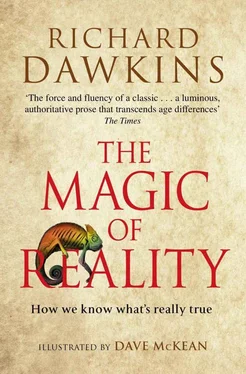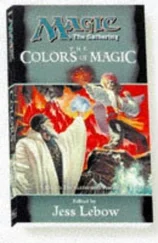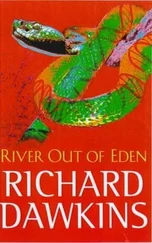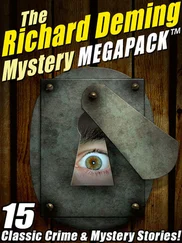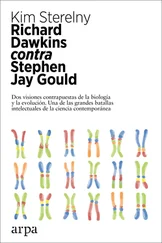Sometimes crystals are made entirely of the same kind of atoms ‘on parade’ – all of the same element. Diamond, gold, copper and iron are examples. But other crystals are made of two different kinds of atoms, again on parade in strict order: alternating, for example. Salt (common salt, table salt) is not an element but a compound of two elements, sodium and chlorine. In a crystal of salt, the sodium and chlorine atoms parade together alternately. Actually, in this case they are called not atoms but ‘ions’, but I’m not going to go into why that is. Every sodium ion has six chlorines for neighbours, at right angles to each other: in front, behind, to left, to right, above, and below. And every chlorine ion is surrounded by sodiums, in just the same way. The whole arrangement is composed of squares, and this is why salt crystals, if you look at them carefully with a strong lens, are cubic – the three-dimensional form of a square – or at least have squared-off edges. Lots of other crystals are made of more than one kind of atom ‘on parade’, and many of them are found in rocks, sand and soil.
Solid, liquid, gas – how molecules move
Crystals are solid, but not everything is solid. We also have liquids and gases. In a gas, the molecules don’t stick together as they do in a crystal, but rush freely about within whatever space is available, travelling in straight lines like billiard balls (but in three dimensions, not two as on a flat table). They rush about until they hit something, such as another molecule or the walls of a container, in which case they bounce off, again like billiard balls. Gases can be compressed, which shows there is a lot of space between the atoms and molecules. When you compress a gas, it feels ‘springy’. Put your finger over the end of a bicycle pump and feel the springiness as you push the plunger in. If you keep your finger there, when you let the plunger go it shoots back out. The springiness that you are feeling is called ‘pressure’. The pressure is the effect of all the millions of molecules of air (a mixture of nitrogen and oxygen and a few other gases) in the pump bombarding the plunger (and everything else, but the plunger is the only part that can move in response). At high pressure the bombardment happens at a higher rate. This will happen if the same number of gas molecules are confined in a smaller volume (for instance, when you push the plunger of a bicycle pump). Or it will happen if you raise the temperature, which makes the gas molecules charge about faster.
A liquid is like a gas in that its molecules move around or ‘flow’ (that’s why both are called ‘fluids’, while solids aren’t). But the molecules in a liquid are much closer to each other than the molecules in a gas. If you put a gas into a sealed tank, it fills every nook and cranny of the tank up to the top. The volume of gas rapidly expands to fill the whole tank. A liquid also fills every nook and cranny, but only up to a certain level. A given amount of liquid, unlike the same amount of gas, keeps a fixed volume, and gravity pulls it downwards, so it fills only as much as it needs of the tank, from the bottom upwards. That’s because the molecules of a liquid stay close to each other. But, unlike those of a solid, they do slide around over each other, which is why a liquid behaves as a fluid.
A solid doesn’t even try to fill the tank – it just retains its shape. That’s because the molecules of a solid don’t slide around over each other like those of a liquid, but stay in (roughly) the same positions relative to their neighbours. ‘Roughly’ because even in a solid the molecules do sort of jiggle about (faster at higher temperatures): they just don’t move far enough from their position in the crystal ‘parade’ to affect its shape.
Sometimes a liquid is ‘viscous’, like treacle. A viscous liquid flows, but so slowly that, although a very viscous liquid eventually fills the bottom part of the tank, it takes a long time to do so. Some liquids are so viscous – flow so slowly – that they might as well be solid. Substances of this kind behave like solids, even though they’re not made of crystals.
Solid, liquid and gas are the names we give to the three common ‘phases’ of matter. Many substances are capable of being all three, at different temperatures. On Earth, methane is a gas (it’s often called ‘marsh gas’, because it bubbles up from marshes, and sometimes it catches fire and we see it lit up as eerie ‘will o’ the wisps’). But on a large, very cold moon of the planet Saturn called Titan there are lakes of liquid methane. If a planet were colder still, it might have ‘rocks’ of frozen methane. We think of mercury as a liquid, but that just means it’s liquid at ordinary temperatures on Earth. Mercury is a solid metal if you leave it outside in the Arctic winter. Iron is a liquid if you heat it to a high enough temperature. Indeed, around the deep centre of the Earth is a sea of liquid iron mixed with liquid nickel. For all I know, there may be very hot planets with oceans of liquid iron at the surface, and perhaps strange creatures swimming in them, although I doubt that. By our standards, the freezing point of iron is rather hot, so at the surface of the Earth we usually encounter it as ‘iron – cold iron’ (Google it. It’s from the poet Rudyard Kipling), and the freezing point of mercury is rather cold, so we usually encounter it as ‘quicksilver’. At the other end of the temperature scale, both mercury and iron become gases if you heat them enough.
When we were imagining cutting matter into the smallest possible pieces at the beginning of this chapter, we stopped at the atom. An atom of lead is the smallest object that still deserves to be called lead. But can you really not cut an atom any further? And would an atom of lead actually look like a tiny little chip of lead? No, it wouldn’t look like a tiny piece of lead. It wouldn’t look like anything. That’s because an atom is too small to be seen, even with a powerful microscope. And yes, you can cut an atom into even smaller pieces – but what you then get is no longer the same element, for reasons we shall soon see. What is more, this is very difficult to do, and it releases an alarming quantity of energy. That is why, for some people, the phrase ‘splitting the atom’ has such an ominous ring to it. It was first done by the great New Zealand scientist Ernest Rutherford in 1919.
Although we can’t see an atom, and although we can’t split it without turning it into something else, that doesn’t mean we can’t work out what it is like inside. As I explained in Chapter 1, when scientists can’t see something directly, they propose a ‘model’ of what it might be like, and then they test that model. A scientific model is a way of thinking about how things might be. So a model of the atom is a kind of mental picture of what the inside of an atom might be like. A scientific model can seem like a flight of fancy, but it is not just a flight of fancy. Scientists don’t stop at proposing a model: they then go on to test it. They say, ‘If this model that I am imagining were true, we would expect to see such-and-such in the real world.’ They predict what you’ll find if you do a particular experiment and make certain measurements. A successful model is one whose predictions come out right, especially if they survive the test of experiment. And if the predictions come out right, we hope it means that the model probably represents the truth, or at least a part of the truth.
Sometimes the predictions don’t come out right, and so scientists go back and adjust the model, or think up a new one, and then go on to test that. Either way, this process of proposing a model and then testing it – what we call the ‘scientific method’ – has a much better chance of getting at the way things really are than even the most imaginative and beautiful myth invented to explain what people didn’t – and often, at the time, couldn’t – understand.
Читать дальше
